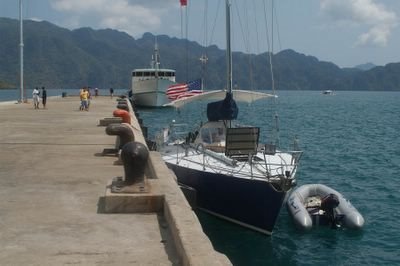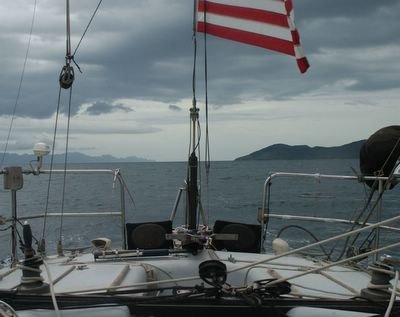March 9, 2006-Westward through Palawan Province
 Coron City Pier
Coron City PierWe weigh anchor at Coron on Thursday and with the awning up and sails stowed, motor slowly to the west through the islands and channels of the Calamian Islands, in Northern Palawan Province. The sky is clear and the wind is light and we lie around on deck in the shade of the awning using the autopilot to steer, watching the chart plotter as we pass islands and around reefs. The visibility is good and it is easy to navigate and we are relaxed, enjoying the peace of the day. We could be sailing but that would mean taking down the awning and getting the sails up and then there would be the stress of sailing in close quarters with the reefs, plus we would be very hot in this direct sun. We make no moves to set sail. This is easier. Anyhow, we need to run the motor to charge the batteries and make water. So we have our excuses.
 Calamian Islands & Seaplane Anchorage
Calamian Islands & Seaplane AnchorageIt is dryer here in this part of the Philippines. There is more brown and less green on the islands than farther to the east. We are amazed at the diversity of islands. Coron Island is shear and jagged, with naked black limestone cliffs and ridges like serrated knife edges. Next to it lies Busuanga Island, with rolling brown hills and savanna like grass. Busuanga has cattle ranches in its interior, including one of the largest in Asia, we were told, and a game reserve with African animals. When we drove across Busuanga to the airstrip on a plain in the middle of the rolling hills we thought it looked like Africa and we could imagine we were somewhere in the middle of that dark continent; maybe Kenya.
We pass Tangat Island, a high volcanic looking cone with sandy beaches in small coves around its base, and nearby there are low islands barely above the level of the sea.
We enjoy the scenery.
Off Tangat Island the breeze freshens a little and a wind chop appears. With the deep blue water and blue sky and the majesty of Tangat Island in the background it is very attractive, and I can visualize sailing here, our boat and its white sails tiny on the blue sea against the tall backdrop of the green mountain. I remember sailing in Canada in places which looked like this, and the images from those days have stayed vivid in my mind for all these years. I look wistfully at the scene. Then the wind switches around and quickly dies. The temptation to sail is gone.
In the afternoon we anchor in Port Culion, a deep indentation just east of the town. Culion is a small, historic, Philippine town built around a hill next to the sea, with many old buildings, including a hospital which housed the large leper colony for which Culion was famous for many years, and a fort. We launch the dingy and motor to the town dock. The security guard allows us to tie our dingy in a small basin next to the passenger terminal. A sign says Welcome to the Culcag Marina. We walk around town and buy some tomatoes and radishes in the market. We hire a tricycle to take us to the old fort and leper sanatorium, and we walk past the church where a service is being conducted. Later, back down along the waterfront, we find a bar called The Safari and we go in for a beer, but it is not very cold.
We return to the boat and cook a chicken we bought, and we discuss our plans for the next few days.
A tropical depression has been on the weather charts since last week, and when it first appeared, off to the east of the Philippines, it was forecast to develop into a typhoon. For a few days we were thinking about preparations we would make for a typhoon. Then it was downgraded to a simple low pressure zone and the current forecast is for it to pass to the south of us and affect us very little, except maybe a couple of days of rain.
We are anxious to get going in the morning and move into another set of islands where we can sit out any rain or wind from the low, but I know that if the sky is cloudy the light will be bad for seeing reefs and we may have to stay here in Port Culion. We decide that it will be OK, this harbor is well protected.
In the morning a north wind blows into the harbor, a good sailing breeze. The sky is grey but I decide we can still see the reefs. We prepare to set sail. I put the jib on deck and lead the sheets. Judy takes off the mainsail cover. We weigh anchor and motor out of the harbor and then we hoist the sails.
It is a beat out of Culion in 15 knots of wind and we are close hauled and pointing high. We have to clear one reef and an island, Chindonan Island, before we can bear off to the west. We take turns on the winches, the other steering. Tacks go silently; we have done this before. Tack on tack we work to weather, it is WINGS best point of sail.
The reef we must avoid is directly upwind of us. We consider tacking to leeward of it or going on until we can clear it to weather. If we go to leeward then we will be very close to the end of Chindonan Island. If we go to weather of it, we will have plenty of room on the island but we will have traveled extra distance. We tack to leeward of the reef and watch the rocks and green water pass close by our starboard side. We are on a good course to weather the island too, but the wind starts to back, knocking us towards the point of the island. The wind also picks up, to 18 knots. Judy is steering and she points us higher. I trim the sails and put on some backstay. We are just clearing Chindonan Island when I spot a piece of bamboo sticking up from what must be a shallow spot just ahead of us. Tack, I say and Judy says, We are not ready!
Tack now! Just turn the boat! I yell. She obeys and puts the helm down. WINGS comes about and I hustle to hand the sheets as fast as she turns. Then she sees the marker, and she says, Good call, Fred.
When we can pass the island we tack back and soon we are around it. We bear off. Our speed comes up as we reach to the West. We put on the autopilot and surge down the wide channel under overcast skies past the islands which looked so beautiful the day before. Now their colors are muted in the grey light. The speedometer shows 7.5. Two small bancas with white triangular sails pass silently across our stern. They look tiny.
 Sailing To Gutob
Sailing To Gutob Fred on Deck
Fred on DeckThe Calamian Islands look good on the charts but reality is different. Our plan of stopping in them is thwarted. There are aqua culture projects which block almost all of the bays and harbors. We think that they are pearl farms, but whatever they are, they prevent us from entering any of the potential refuges we had picked out from the chart. Then when we can get into some places, we find that the water is too deep. Eighty six feet of water right up to the reef makes for difficult anchoring. We continue to the west.
In the afternoon the wind has died and we motor along. We have put the pearl farms behind us and we are near the west end of the Calamian Islands. We proceed up into Gutob Bay where we find the water is shallow enough to easily anchor and no aqua culture. We pass a resort on one island and a town on another. We anchor in a cove which affords protection from all sides, off of a small boat house on shore.
 Gutob Bay
Gutob BayThe rain comes just after we get the hook down; a thick grey cloud of rain blocks the horizon and moves toward us. When it comes the soft rain washes off the boat. Dust on our decks which has been there since Semirara Island is rinsed away. We set up the water collection system and hope it rains long enough to fill the tanks.
The rain also cools us. It is good.
We can hear a cow mooing from the island.
We eat our meal and drink our wine on deck as night falls. We are happy.
Fred & Judy, SV Wings, Gutob Bay, the Philippines
Lat 12deg 10.02 North, Lon 119deg 51.667 East.
Click these links for more photos of Culion Town
Church
School Girls
Safari Bar
Culion Hospital
Stilt Houses
----------
radio email processed by SailMail
for information see: http://www.sailmail.com
Labels: Philippines, sailing

.jpg)

0 Comments:
Post a Comment
<< Home